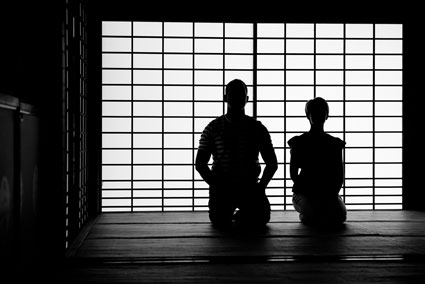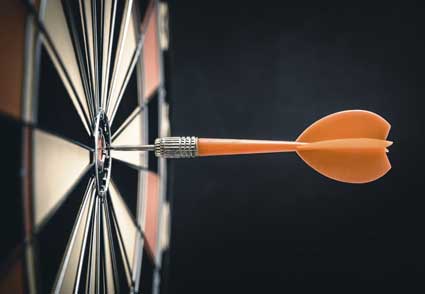Techniques in Meditation
Keep in mind that being comfortable is of paramount importance in meditation. If you find that any of these techniques do not make you feel comfortable and relaxed, you will not be able to achieve the deep concentration and relaxation necessary for effective meditation. You need not feel obligated to perform a technique just because you think it's a "classic" meditation pose or posture, or because someone else recommended it. Find the technique that best suits you.
As we discussed in the chapter on proper posture, sitting meditation is the most common technique for meditation. You need not sit absolutely motionless for hours on end – such a pose would most certainly lead to discomfort. Keep your meditation practices fluid. If you feel the need to reposition yourself, do so. If, for example, you are meditating in a lotus position, you may cross your legs in the opposite directions after a period of time if you wish.
Meditation is about being where we are – in the present. But, disturbances will occur and part of the process of meditating is to acknowledge these distractions, deal with them, and banish them if at all possible. During sitting meditation, your comfort itself might be a distraction. If the blood flow in your legs is restricted, you might not be able to achieve the level of comfort you need to fall into a deep concentration. You may be better suited for chair meditation. Do not judge your ability to sit and meditate. It is vital that you not concern yourself with petty issues such as the position in which you meditate. The position is not the point – your level of concentration and self-awareness is the goal.
When you first begin meditating, sit without trying to meditate. Create your physical space around you. We spent an entire chapter discussing physical for meditation because it is important. Incorporate a cushion if you wish, as many expert practitioners do.
As you begin your first few practices, sit and prepare yourself for meditation without actually meditating. Feel the support of the floor under you. Make yourself comfortable and just enter into a relaxed state. Spending a few minutes listening to the birds or even the traffic outside can relax you – and this is the beginning of meditation.
Many people meditate in a bright room. This will keep your brain alert. There is a difference between feeling very relaxed, the goal of meditation, and feeling tired and sleepy. You do not want to fall asleep. If you do, don't berate yourself. Perhaps you do not give yourself many opportunities to sit quietly and relax. If this is the case, during your first few practices, you may indeed fall asleep as you give your body the rest it is seeking. This is fine – just persevere. Next time, try harder to stay alert by making any adjustments you feel necessary.
Some meditation practitioners who fall asleep easily use the sit-stand method while meditating. Sit and meditate for 15-20 minutes, then stand for 2 minutes. While standing, perhaps you could perform the yoga pose known as "mountain pose." (See chapter on meditation and yoga). When you are finished standing, you may sit for another 15-20 minutes to continue your meditation. You may continue this sitting and standing cycle for as long as you wish. The periodic standing will increase our flow of blood, but we can continue in our state of relaxation. The increased blood flow will maintain our sense of alertness, and moving will not at all distract you from achieving an effective meditation. Indeed, as we shall explore in the chapter on yoga, movement in meditation is extremely effective.
Now that we know the proper posture and technique for sitting meditation, let's explore some tips on how to enter into a state of deep relaxation and concentration. Quieting the mind means to "let go of the doing." Be passive rather than active. Be observant, but do not actively seek.
To clear your mind, you may want to use a technique called "sweeping house" that is used by many people who meditate. You may use this method at the beginning of your practice to quiet your mind, but you might find it beneficial to return to it several times throughout your practice if you find yourself getting distracted.
Place both hands behind your head, and rest them where the neck and head meet. Quickly sweep your hands over your head. As you do so, imagine that your hands are gathering all the thoughts inside your head. Move your hands across the top of head all the way down to your forehead. When you get to your forehead, quickly move your hands away from your head in a flourish, feeling all your thoughts being dispelled from your mind. Envision all your cares and thoughts drifting off into empty space. Repeat this motion rapidly for 10-20 times, or as long as you think you need to do so.
After you have entered into a state of relaxation by concentrating on your breath, you may begin a formal meditation on a specific topic, question, or thought.
Ask yourself a question. It may be a question you have been grappling with for several days, or it might be a question that immediately pops into your mind. If there is a particular topic that has encouraged you to meditate in a given day, you obviously should ask yourself that question.
Ask yourself the question as if you had only one hour left to live and your life depended on the answer. Your mind, at this point, should be free of distractions and in a relaxed state. The thoughts that arise when you ask your question may be very insightful. Do not fret, though, if an answer or a thought is not immediately evident to you. You might need to "sit with your question" for several sessions. This is perfectly acceptable. Anything worth having or striving for is worth the effort.
Do not follow a distracting thought to its conclusion. Also, do not pay attention to the context of a thought or place a value judgment on it. It does not matter whether it is a good or bad thought. While wholesome thoughts are better than unwholesome ones, in Vipassana Meditation, these concerns are not important. What is important, however, is to notice whether you are able to quickly analyze and dismiss a thought. Some thoughts will be more readily dealt with while others are deeper and more complicated. We cannot control what thoughts will occur in our mind during Vipassana, or Insightful Meditation, but we can control our responses to them. Pay attention to what thoughts linger. They may contain answers, or they make teach you something about yourself.
In some ways, it is incorrect to call morning pages and artist's dates "supplements." To many people, they are meditation. In fact, the person who invented both of these techniques, Julia Cameron, once called morning pages "meditation for Westerners."
Julia Cameron's bestselling book The Artist's Way has been read by CEOs of Fortune 500 companies as well as by beginning artists. It has been read by people who are at the pinnacle of their careers, and by people who are just starting out in a new profession. It is a groundbreaking book on how to increase your creativity and find your true passion in life.
In The Artist's Way, Cameron spends a good deal of time describing two activities – morning pages and artist's dates – that are instrumental in helping people better discern their thoughts, clear their minds, and make them more receptive to creative energy. No course on meditation would be complete without spending some time with these two activities.
When we practice Vipassana Meditation, or Insightful Meditation, we are usually concentrating on a single thought or question. Other thoughts will arise throughout our meditation and we have learned various methods to deal with these extraneous thoughts. This single thought or question might be a very important question that we have been dealing with in our lives for some time, or it could be something that we have only just discovered.
The practice of doing morning pages will help us discern these questions for meditation. In fact, the very process of doing morning pages is meditation.
So what are morning pages? They are three pages of freely written text each morning. That's it. For twenty minutes each morning, as soon as your arise, you will write three pages of text in a notebook. Do not be concerned with how long the pages are, or what type of notebook you use. You will just write three pages of thoughts – whatever comes to your mind.
These three pages are a stream of consciousness. They are not finely-crafted prose. They will never be read by anyone, and they do not have to stand up to anyone's standards. Morning pages are three pages of text written everyday just for you.
Morning pages are random thoughts. There will be times when you do not have a thought at all. In those times, you might simply write "I do not have a thought" over and over again, until you do have one. At first glance, you might wonder about the effectiveness of simply writing the most mundane thoughts, but over time, you will marvel at the power of morning pages. On some days, the thoughts you will write will surprise you. You will wonder where they came from. These are the types of questions you will want to ponder. This is meditation.
You will – beyond the shadow of a doubt – meet with resistance. There will be many days when you do not want to write. On some days, you will be afraid to write. These are the days when you need to write the most. As Cameron explains, these are the days when we have something lurking in our mind that wants to be found.
These pages should be done in the morning. While they are effective at any time during the day, they are most effective just as you arise. Perhaps you can arise 20 minutes earlier than you normally do - so that you have some private, quiet time for yourself. If you do your pages in the evening, or after a day's worth of activities, you might find yourself simply writing about your day. You might write about your day at work, or simply record the day's events chronologically. While writing about your life's events is indeed a part of morning pages, you do not want your pages to become a simple litany of complaints and performed tasks. You want your pages to be a collection of thoughts. The quiet of the morning will be the most effective time for you to do your pages.
Blocked thoughts, or blocked creative energy, will be released during your morning pages sessions. The process is very similar to Vipassana Meditation. You will strip away all the extraneous thoughts to get to the heart of the matter. You will get to the truth. The thoughts that arise during your morning pages will help guide you and they will form a basis for the thoughts that frame your meditation practices.
An "artist date," as Cameron calls it, is the perfect complement to your morning pages. In our morning pages, we are posing questions. In meditation, and in artist's dates, we often receive the answers.
An artist's date is a pre-planned, pleasurable activity that you spend doing just with yourself. It is a weekly event, and you can spend this time any way you please. Perhaps during your morning pages this week you discovered that you have wanted to see that new exhibit at the museum. That would be an ideal artist's date.
Do not think that artist's dates need to be elaborate or expensive. Taking a walk in the park, or cleaning your bathtub (if you particularly enjoy cleaning), could be examples of artist's dates. This week you might have discovered that you have always wanted to take a class at your local community college. Taking a drive to the college, picking up a catalog, and sitting in the park reading it is the perfect example of an artist's date.
As Cameron explains, we all have an inner child who wants – and needs – to be nourished. You should be listening to this inner voice during your morning pages sessions and during your meditation practices. When we are a child, we are usually not burdened by the stresses of everyday life. Children always live in the present. Your inner child does as well. If you listen to what your inner child is saying, you will discover a great deal about yourself.
Do not think that anything is too silly for an artist's date. Do not get consumed with the ways you think something should be. Keep an open mind and let your creative energy flow. Cameron calls this inner critic our "sensor." Our sensor often works against us, and you must learn how to quiet your censor. This is often not an easy process, and the strength you acquire during meditation will help you a great deal.
Just as you will sometimes meet with resistance – from yourself – to do morning pages, you may often meet with resistance from yourself and other people for taking an artist's date. You will sometimes think it is selfish when you take a half hour for yourself to engage in a pleasurable activity when other members of your household, for example, might not do so. Explain to your friends and family what you are doing. Talk to them about your experiences of doing morning pages, meditation, and artist's dates. You may find that they will want to join you, but remember, artist's dates should always be done alone. This is your time and your time only. Bringing someone along, no matter how close you are to them, will change the dynamic of the experience.
Meditation is a journey leading to radiant well-being, self-awareness, and self-discovery. Do not rush the journey. Enjoy and savor every moment.































